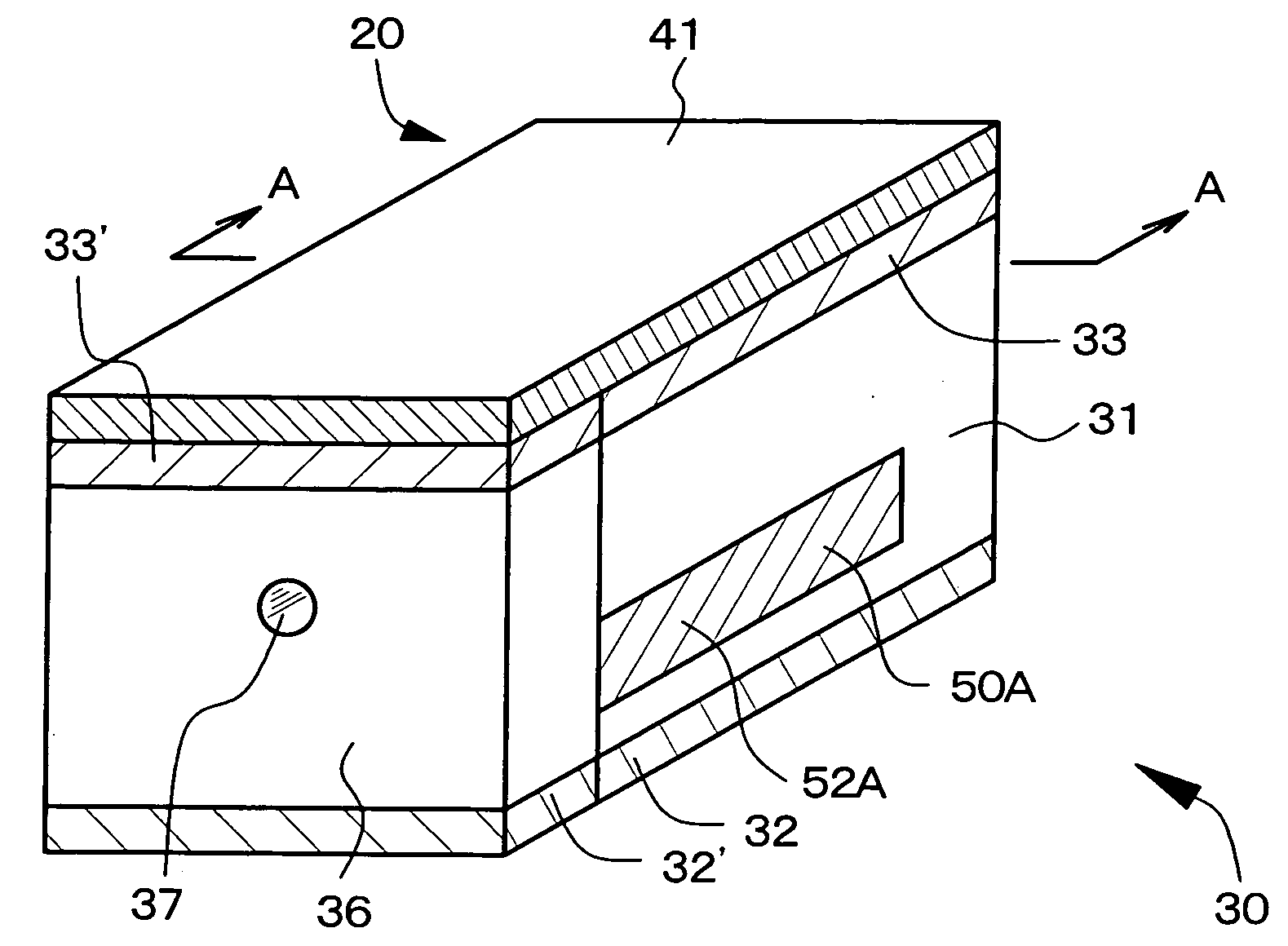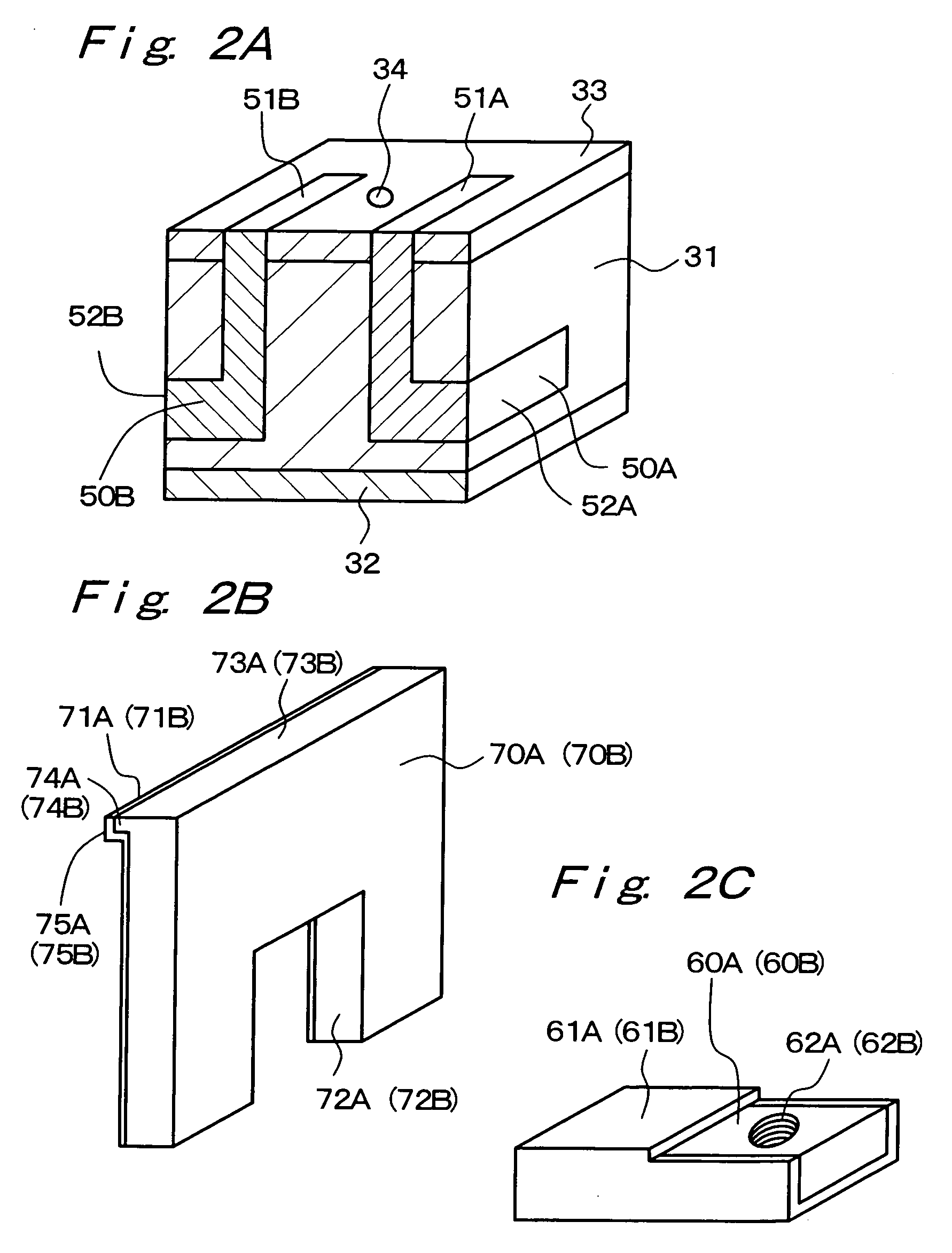Mold Assembly
a technology of mold assembly and molded parts, which is applied in the field of mold assembly, can solve the problems of easy generation of strain inside the molded article, insufficient heat generation, and breakdown of electrically conductive layers, and achieves the effect of easy generation of strain and easy appearance failur
- Summary
- Abstract
- Description
- Claims
- Application Information
AI Technical Summary
Benefits of technology
Problems solved by technology
Method used
Image
Examples
example 1
[0177]Example 1 relates to the mold assembly according to the first aspect of the present invention, more specifically, it relates to the mold assembly of the first constitution. FIG. 1(A) shows a schematic perspective view of an insert block assembly in the mold assembly of Example 1, and FIG. 1(B) shows a schematic cross-sectional view taken along arrows A-A in FIG. 1(A). FIG. 2(A) shows a schematic perspective view when the insert-block body, etc., are cut along arrows A-A in FIG. 1(A), FIG. 2(B) shows a schematic perspective view of a side block, and FIG. 2(C) shows a schematic perspective view of a first electrode and a second electrode. Further, FIG. 3 shows a perspective view of the insert-block body, etc., before they are assembled, and FIGS. 4(A) and 4(B) show conceptual views of the mold assembly and an injection molding apparatus as a whole. In FIG. 1(A), slanting lines are provided to some components for clearly showing components. FIG. 5, FIG. 6(A), FIG. 8, FIG. 9(A) an...
example 2
[0193]Example 2 is a variant of Example 1. In Example 2, as FIG. 5 shows a schematic cross-sectional view, a first conducting means 80A and a second conducting means 80B are formed of electrically conductive bolts (specifically, made of carbon steel) whose top end portions correspond to first end portions 81A and 81B, whose head portions correspond to second end portions 82A and 82B and which extend inside the insert block 30 (specifically, extend through the insert block 30 in Example 2) and are electrically insulated from the insert-block body 31. The top ends of the bolts are threadedly engaged with the heat-generating member 41 and the head portions of the bolts are in contact with the electrodes (not shown). That is, the second end portion 82A in the first conducting means 80A and the second end portion 82B in the second conducting means 80B are exposed in the bottom surface of the insert-block body 31. Since other components of the insert block assembly can be formed like the ...
example 3
[0194]Example 3 also relates to the mold assembly according to the first aspect of the present invention, and more specifically, it relates to the mold assembly of the second constitution. FIG. 6(A) shows a schematic cross-sectional view of an insert block assembly in a mold assembly of Example 3, and FIG. 6(B) shows a schematic perspective view obtained when an insert-block body is cut. Further, FIG. 7(A) schematically shows a pattern of a first conductive region, a conductive-region-extending area and a second conductive region in the mold assembly of Example 3.
[0195]The basic constitution and structure of the mold assembly in Example 3 are the same as the constitution and structure of the mold assembly explained in Example 1. And, an insert block 130 in Example 3 is constituted of the insert-block body 31 similar to that in Example 1 and the insulating layer 33 similar to that in Example 1. Further, the insert block 130 is constituted of a first conductive region 139A, a second c...
PUM
| Property | Measurement | Unit |
|---|---|---|
| Temperature | aaaaa | aaaaa |
| Length | aaaaa | aaaaa |
| Length | aaaaa | aaaaa |
Abstract
Description
Claims
Application Information
 Login to View More
Login to View More - R&D
- Intellectual Property
- Life Sciences
- Materials
- Tech Scout
- Unparalleled Data Quality
- Higher Quality Content
- 60% Fewer Hallucinations
Browse by: Latest US Patents, China's latest patents, Technical Efficacy Thesaurus, Application Domain, Technology Topic, Popular Technical Reports.
© 2025 PatSnap. All rights reserved.Legal|Privacy policy|Modern Slavery Act Transparency Statement|Sitemap|About US| Contact US: help@patsnap.com



